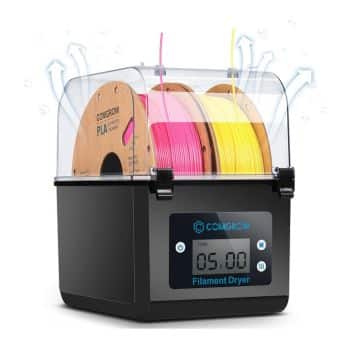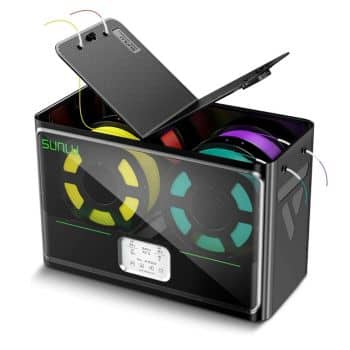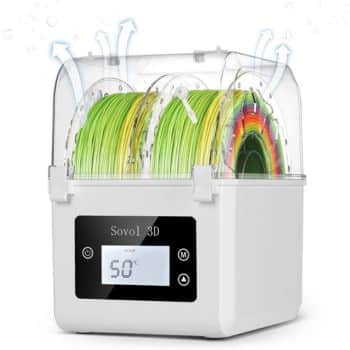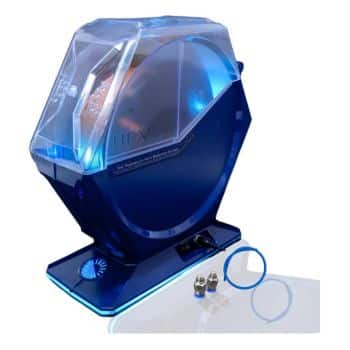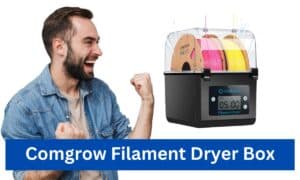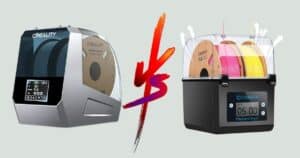
The Polymaker PolyDryer wins for serious 3D printers with its versatile, well-sealed design, while the Comgrow Filament Dryer at $39.99 suits budget beginners with solid drying power.
When it comes to 3D printing, one of the most common concerns among enthusiasts and professionals alike is filament quality. Have you ever experienced issues like stringing, poor layer adhesion, or even failed prints? If so, you’re not alone! Many 3D printing aficionados grapple with the challenges posed by moisture-absorbing filaments, especially when using materials like PLA, PETG, and Nylon. The good news is that there’s a solution: filament dryers. In this article, we’ll explore the best filament dryers for 3D printing available on the market and how they can help improve your 3D printing experience.
The Best Filament Dryers for 3D Printing: Top 8 Picks (Web Story)
Why Should You Consider a Filament Dryer?
Affiliate Disclosure
We participate in Amazon affiliate programs, earning fees from qualifying purchases via links at no extra cost to you. It’s how we keep this blog rolling and my 3D printers buzzing with fresh filament for reviews like this one!
Have you ever wondered whether investing in a filament dryer is really worth it? It’s a valid question! You might be thinking, “Can’t I just store my filament in a sealed bag or container?” While that’s a great start, it may not be enough to combat the moisture that can accumulate over time.The truth is that many filaments are hygroscopic, meaning they absorb moisture from the air. This absorbed moisture can lead to a range of printing problems, including bubbling, oozing, and inconsistent extrusion. By using a filament dryer, you can effectively remove moisture from your filaments before printing, leading to better print quality and fewer headaches.
Understanding Moisture and Filament Quality
Moisture can wreak havoc on your 3D printing projects. When filament absorbs water, it can cause the following issues:
- Bubbling: When heated during extrusion, trapped moisture turns into steam and creates bubbles in the filament. This leads to an uneven surface finish and weak layers.
- Poor Layer Adhesion: Moisture-laden filaments may not bond properly during printing, resulting in weak spots and potential failures.
- Stringing and Oozing: Excess moisture can cause stringing between parts of your print as the filament expands and contracts unpredictably.
Understanding these issues can help you appreciate the importance of keeping your filaments dry.
Practical Advice for Using Filament Dryers
So how do you choose the best filament dryer for your needs? Here are some practical tips:
- Temperature Control: Look for dryers that allow you to set specific temperatures based on the type of filament you’re using. For example, PLA typically requires lower temperatures than Nylon.
- Capacity: Consider how much filament you typically use at once. If you’re working with multiple spools or larger quantities, opt for a dryer with higher capacity.
- Ease of Use: Choose a dryer with an intuitive interface and easy-to-read display so you can monitor drying times and temperatures without hassle.
- Portability: If you plan to move your dryer around frequently or have limited space, consider a compact model that’s easy to store.
- Safety Features: Ensure that the dryer has built-in safety features such as automatic shut-off mechanisms to prevent overheating.
Best Filament Dryers for 3D Printing in the Market
1. Polymaker 3D Printing Filament Dryer and Storage Box
The Polymaker PolyDryer is a comprehensive solution for 3D printing enthusiasts, designed to dry and store filaments effectively. This innovative system combines a drying dock with modular storage boxes, allowing users to maintain optimal conditions for their filament. The PolyDryer addresses common challenges associated with moisture in 3D printing materials, which can lead to issues like stringing and poor adhesion. With its precise heat control and superior sealing capabilities, the PolyDryer ensures that filaments remain dry and ready for use, enhancing print quality and reliability.
Key Features
- Modular Design: Comprises a Dryer Dock for heating and multiple PolyDryer Boxes for storage, allowing customization based on user needs.
- Efficient Drying: Utilizes a 360° airflow system for even drying of filaments without damage, compatible with various materials.
- Heat Control: Features three preset power levels and an adjustable timer for tailored drying cycles.
- Versatile Compatibility: Supports various spool sizes up to 1 kg and multiple filament types including PLA, ABS, PETG, TPU, and Nylon.
- Superior Sealing: The storage boxes provide excellent sealing performance to protect filaments from moisture and dust.
- Continuous Drying Mode: Allows indefinite drying cycles, beneficial for hygroscopic materials.
- Color-Changing Desiccant: Included desiccant changes color to indicate humidity levels inside the storage box.
Pros
- Customizable Setup: Users can add multiple storage boxes to accommodate different spools.
- User-Friendly Operation: Simple controls make it easy to operate without extensive instructions.
- Durable Construction: Built with quality materials ensuring longevity and reliability.
- Effective for Common Filaments: Works well with standard materials like PLA and PETG.
Cons
- Noise Level: The operation can be relatively loud, around 60 dB, which may be disruptive in quiet environments.
- Temperature Limitations: Maximum drying temperature is capped at 60°C, which may not be sufficient for high-temperature filaments like Nylon.
- Firm Latches: The latches on the storage boxes can be difficult to open for some users.
Related: Polymaker PolyDryer Review: Top Filament Dryer to Buy in 2025
2. Creality Space Pi Filament Dryer Plus

The Creality Space Pi Filament Dryer Plus is an innovative solution designed for efficient filament drying, ensuring optimal performance during 3D printing. With a two-roll capacity, it can accommodate up to two 1 kg filaments simultaneously, making it ideal for users with multiple printers or diverse filament types. This system not only enhances the quality of 3D prints but also simplifies the drying process, making it a valuable addition for both hobbyists and professionals in the 3D printing community.
Key Features:
- 360° Hot-Air Heating: Utilizes double PTC heating technology for uniform drying, effectively eliminating moisture that can lead to printing issues like stringing and clogging.
- Adjustable Temperature: Offers a temperature range from 45°C to 70°C, allowing customization based on the filament type.
- Real-Time Monitoring: Equipped with an LCD touch screen for easy tracking of humidity and temperature conditions.
- Flexible Drying Time: Users can set drying durations from 0 to 48 hours, ensuring thorough moisture removal for improved print quality.
Pros
- Adjustable Temperature: Allows temperature adjustments between 45°C and 70°C for different filament types.
- Real-time Monitoring: Provides real-time humidity and temperature monitoring.
- 360° PTC Hot-air Heating: Ensures fast and efficient drying with uniform heat distribution.
- LCD Touch Screen: Features a 3.7-inch touch screen for easy operation and tracking.
- One-Key Filament Setting: Supports temperature settings for up to 12 filament types, including PLA-CF, PA-CF, and ASA.
- Timer Function: The heating duration can be set from 0 to 48 hours.
- Power-off Memory Function: Remembers previous settings after a power outage, eliminating the need for resetting.
- Compatibility: Compatible with multiple filament diameters (1.75mm and 2.85mm).
- Fast Drying: The advanced PTC heating technology ensures quick and efficient drying.
- Quiet Operation: Users have noted that the device operates quietly during use.
Cons
- Noise: Some users find the dryer loud, making it unsuitable for use in sleeping areas.
- Filament Feeding: Difficulty in feeding filament into the extruder due to the long run.
- No Exhaust for Humid Air: Lacks a mechanism to exhaust humid air, though DIY solutions are available.
- Limited Voltage Compatibility: Requires purchasing the correct version for either 110V or 240V power grids, unlike some cheaper appliances that work with both.
- Support Issues: Some customers have reported unsatisfactory customer support and slow shipping times.
- Price: Some users feel the price is high for what it offers, especially considering the shipping costs.
Related: Creality Space Pi Plus Filament Dryer Review: Say Goodbye to Moisture Issues
Related: Creality Official Filament Dryer Box 2.0 Review
3. Comgrow 3D Printer Filament Dryer Box
The Comgrow 3D Printer Filament Dryer Box is a specialized device designed to keep 3D printing filaments dry and free from moisture, which is crucial for achieving high-quality prints. This dryer box is compatible with various filament types, including PLA and ABS, and can accommodate standard filament diameters of 1.75mm and 2.85mm. With its adjustable temperature settings and real-time monitoring capabilities, the Comgrow dryer box aims to enhance the performance of 3D printers by preventing common issues associated with damp filaments.
Key Features
- Large Storage Volume: The dryer box can store two rolls of 1kg spools or one roll with a width of less than 150mm, making it suitable for multiple filament types.
- Temperature Control: It offers an adjustable temperature range from 40°C to 50°C, allowing users to set the optimal drying conditions for their specific filament needs.
- Real-Time Monitoring: Equipped with a 2-inch LCD screen, the dryer box displays both temperature and humidity levels inside the unit, providing users with immediate feedback on the drying process.
- Sealed Storage Design: The box features a silicone cable sheath and Teflon tube for smooth filament outlet, ensuring minimal moisture ingress when not in use.
- User-Friendly Operation: The device includes touch buttons for easy adjustment of temperature and drying time, which can be set between 6 to 12 hours.
Pros
- Effective Moisture Removal: Successfully reduces humidity levels in filaments, which helps prevent printing issues like clogging and poor adhesion.
- Versatile Compatibility: Works well with various filament types, including PLA, ABS, PETG, and ASA.
- Convenient Filament Feeding: Allows users to print directly from the dryer while it’s operational, enhancing workflow efficiency.
- Compact Design: Its size makes it easy to fit on a desk or workspace without occupying much room.
Cons
- Interface Complexity: Some users find the control interface confusing and not intuitive, making it challenging to adjust settings quickly.
- Temperature Limitations: The maximum temperature of 50°C may not be sufficient for all filament types or conditions.
- Inconsistent Quality: There are reports of varying performance between different units, with some users experiencing issues with humidity readings and heating efficiency.
Related: Comgrow SH02 Filament Dryer Box Review: Does it Really Work?
4. Sunlu FilaDryer S4
The SUNLU Official 3D Printer Filament Dryer S4 is designed to enhance the 3D printing experience by effectively drying various types of filaments. With a capacity to hold up to four spools, this dryer utilizes a powerful 350W PTC heater and three circulation fans to ensure even drying and optimal filament performance. It supports a wide range of materials including PLA, ABS, PETG, and Nylon, making it a versatile tool for both hobbyists and professionals. The device also features adjustable temperature settings and a timer, allowing users to customize the drying process according to their specific needs. By maintaining optimal moisture levels, the SUNLU S2 Filament Dryer not only saves time and reduces material waste but also enhances the reliability and consistency of 3D printing results.
Key Features:
- Touch Screen Operation: The 4.6-inch LCD touch screen provides a user-friendly interface, allowing easy navigation and quick adjustments to temperature settings for various filament types.
- Drying While Printing: The innovative design allows filaments to dry continuously during the printing process, ensuring they are ready for use without interruption.
- Wide Compatibility: Compatible with standard filament diameters (1.75mm, 2.85mm, and 3.00mm), it supports a variety of materials including PLA, PETG, and high-performance filaments like PA and PC.
Pros
- High Capacity: Can dry up to four 1kg spools simultaneously, which is ideal for users with multiple printers or large projects.
- Efficient Drying: Equipped with three circulation fans and a 350W heater for consistent temperature and faster drying times.
- Versatile Compatibility: Supports a variety of filament types including PLA, ABS, TPU, and Nylon, accommodating different printing requirements.
- User-Friendly Controls: Features adjustable temperature settings (35-70°C) and a timer (0-99 hours) for tailored drying cycles.
- Smart Functionality: Monitors humidity levels and automatically resumes operation when moisture is detected, ensuring filaments remain dry.
Cons
- Size: The large dimensions may require significant space in a workshop or home environment.
- Noise Level: Some users report that the dryer can be noisy during operation, which may be disruptive in quiet settings.
- Durability Concerns: A few reviews mention issues with reliability over time, including thermistor errors that require troubleshooting or repairs.
Related: Why Risk Poor Prints? SUNLU FilaDryer S4 Guarantees Dry, Ready-to-Use Filament!
Related: SUNLU FilaDryer SP2: 2-in-1 Dryer Drops May 19!
5. Sovol SH01 Filament Dryer
The Sovol SH01 Filament Dryer is a highly efficient solution designed to maintain the quality of 3D printing filaments by effectively removing moisture. With an inner size of 9.29 x 6.49 x 9.13 inches, this dryer can accommodate two 1 kg spools, making it ideal for users with multiple filament types. The Sovol SH01 not only helps prevent common printing issues such as clogging and poor adhesion but also provides a user-friendly experience, making it a valuable addition for any 3D printing enthusiast.
Key Features:
- Adjustable Temperature and Time: Users can set the temperature between 40°C and 50°C and choose drying times from 6 to 12 hours, ensuring optimal conditions for various filament materials.
- Real-Time Monitoring: A 2-inch LCD screen displays current temperature and humidity levels, allowing for easy tracking of drying conditions.
- Excellent Sealing: The silicone seal ensures long-term storage without power, protecting filaments from moisture and dirt while enhancing drying efficiency when combined with desiccants.
Pros
- Efficient Drying: Provides effective drying and restores the performance of 3D printer filaments by removing moisture.
- Real-time Monitoring: Equipped with a 2-inch LCD screen and touch buttons for easy operation and real-time monitoring of temperature and humidity.
- Adjustable Settings: Temperature range adjustable between 40°~ 50°C and drying time from 6 to 12 hours.
- Sealed Storage: Features a silicone seal that allows for long-term filament storage without power and protects filaments from moisture and dirt.
- Multiple Filament Compatibility: Can store and dry 2 rolls of 1kg spools simultaneously, and it has four holes to choose from for filament feeding.
- User-Friendly: Simple to use with an easy-to-read display and straightforward operation.
- Quiet Operation: Operates quietly, making it suitable for various environments.
- Affordable: Priced competitively, offering good value for the features provided.
Cons
- Manual Settings: Requires manual entry of temperature and time settings.
- Limited Timer: The timer can only be set between 6 to 12 hours, with no option for continuous operation.
- Lack of Memory: Does not have a memory function for retaining settings after power off.
- Basic Features: Lacks advanced features such as automatic mode activation based on humidity levels.
- Separate Shipments: Depending on location and stock, orders might be shipped separately, leading to different delivery times for items.
Related: Sovol SH01 Filament Dryer 2025 Review: Best Budget Pick for 3D Printing?
6. EIBOS 3D Printer Filament Dryer Box
The EIBOS Polyphemus 3D Printer Filament Dryer Box is designed for 3D printing enthusiasts who require a reliable solution for maintaining the quality of their filaments. This dryer features an innovative automatic rotation function, ensuring even heat distribution while drying various filament types, including PLA, ABS, Nylon, and more. With a spacious capacity for up to 3kg spools and advanced humidity control, the Polyphemus aims to enhance the performance of 3D printing materials by preventing moisture absorption, which can lead to print failures.
Key Features:
- Automatic Rotation Function: The dryer includes a geared motor for 360° surround heating, promoting uniform temperature throughout the drying chamber.
- Extra Large Capacity: Accommodates both standard 1kg spools and larger 3kg spools with an extension kit, allowing for simultaneous drying of multiple spools.
- Automatic Humidity & Temperature Control: Maintains a specific humidity level and offers adjustable drying temperatures from 20℃ to 70℃ with customizable time settings.
- Efficient Heating System: Utilizes a 130W PTC heating element combined with a hot air circulation system and eight vents for effective moisture removal.
- Storage Options: Features compartments for desiccants and plugs for sealed protection against dust and moisture when not in use.
Pros
- Effective Drying: The combination of rotation and temperature control significantly improves filament quality, restoring dried filaments to near-new condition.
- Versatile Compatibility: Works with various filament types and diameters (1.75mm, 2.85mm, 3.00mm), making it suitable for a wide range of materials.
- User-Friendly Interface: Easy-to-navigate settings allow users to select filament types and adjust drying parameters effortlessly.
- Quiet Operation: Operates at a low noise level (35-36 dB), making it suitable for home or office environments.
Cons
- Initial Cost: The price may be higher compared to other filament dryers on the market, which could deter some potential buyers.
- Durability Concerns: Some users report issues with fan noise and heating consistency after a few months of use, raising concerns about long-term reliability.
- Limited Customer Support: Instances of difficulty in contacting customer service for warranty issues have been noted by users.
7. THETA°NanoHex° Filament Dryer Box
The THETA°NanoHex° Filament Dryer Box is designed to enhance the 3D printing experience by effectively managing filament moisture levels. This automatic filament storage dehydrator is compatible with various filament types, including PLA, ABS, PETG, and Nylon, making it a versatile tool for both hobbyists and professionals in the 3D printing community. With its user-friendly design and advanced features, the NanoHex aims to improve print quality by preventing issues like stringing and clogging caused by moisture absorption.
Key Features
- One-Button Operation: Simplified usage with a single button to start the drying process.
- Adaptive and Hex° Modes: Offers energy-efficient humidity control and optimal drying performance.
- 360° Heat Transfer: Advanced technology ensures even heat distribution for effective moisture removal.
- Smart Engineering: Utilizes AI technology for low humidity maintenance while minimizing power consumption.
- Fast Dehumidification: Capable of dehumidifying the chamber in just 10 minutes.
- Compatibility: Works with various filament sizes (1.75mm, 2.85mm, 3.00mm) and materials (PLA, ABS, PETG, TPU, Nylon, PEEK, HIPS).
- User-Friendly Design: ROHS-compliant construction that is simple to use and fully recyclable.
Pros and Cons
Pros
- Improved Print Quality: Reduces issues like stringing and warping by effectively drying filament.
- Energy Efficient: The adaptive mode helps conserve energy while maintaining optimal conditions.
- Easy Setup: Simple installation process with minimal operational complexity.
- Quiet Operation: Generally operates quietly compared to other models on the market.
Cons
- Limited Feedback: Lack of a display or detailed feedback on humidity levels can lead to uncertainty about the drying process.
- Build Quality Concerns: Some users have reported that the materials feel cheap or flimsy over time.
- Noise Issues: While generally quiet, some users experienced intermittent noise from the fan after extended use.
8. Kingroon Filament Dryer Box
The Kingroon Filament Dryer Box is an innovative solution designed to address common issues faced by 3D printing enthusiasts, such as filament moisture absorption, which can lead to problems like stringing and poor adhesion. This upgraded dryer features a 360° heating mechanism combined with a fan to ensure even drying of various filament types, making it a versatile addition to any 3D printing setup.
Key Features of Kingroon Filament Dryer Box
- Personalized Settings: Adjustable timer controls from 0-24 hours. Three temperature settings: 50℃, 60℃, and 70℃, catering to different filament types.
- Effective Moisture Removal: Utilizes 360° surround heating for efficient drying. Helps mitigate issues like stringing, clogging, and adhesion problems.
- Fast Drying with Fan: Incorporates a built-in fan that accelerates the drying process by quickly expelling excess moisture.
- Wide Compatibility Range: Compatible with standard filament diameters: 1.75mm, 2.85mm, and 3.00mm. Works effectively with various materials including PLA, ABS, PETG, TPU, ePA-CF, ePA-GF, and PC.
- Safety Features: Translucent design allows for visibility while protecting filaments from dust and moisture. Automatic standby mode after the timer expires ensures safe operation.
Pros
- Versatile Compatibility: Supports a wide range of filaments, making it suitable for diverse printing needs.
- Customizable Drying Options: The adjustable timer and temperature settings allow users to tailor the drying process based on specific filament requirements.
- Efficient Moisture Management: The combination of surround heating and fan technology significantly reduces moisture levels in filaments, enhancing print quality.
Cons
- Weight: At 2.3 pounds, it may be less portable compared to lighter alternatives.
- Temperature Limitations: The maximum temperature of 70℃ may not be sufficient for certain high-temperature filaments.
Related: Kingroon Filament Dryer Box 2025 Review: Top Features, Pros, Cons & Where to Buy
Comparison Table of Filament Dryers
This comparison table summarizes the key features of above eight filament dryers. Each dryer has its unique strengths and weaknesses catering to different user needs in the realm of 3D printing.
| Filament Dryer | Capacity | Temperature Range | Drying Time | Key Features | Pros | Cons | Price |
|---|---|---|---|---|---|---|---|
 Polymaker PolyDryer Polymaker PolyDryer | Up to 1 kg | Adjustable | Continuous | Modular design, 360° airflow, color-changing desiccant | Efficient drying, versatile compatibility, excellent sealing | Higher price point | Buy Now ($79.99) |
 Creality Space Pi Filament Dryer Plus Creality Space Pi Filament Dryer Plus | Up to 2 kg | 45°C to 70°C | 0-48 hours | LCD touch screen, real-time monitoring, adjustable settings | Adjustable temperature, fast drying, quiet operation | No exhaust for humid air, some noise | Buy Now ($99.99) |
 Comgrow 3D Printer Filament Dryer Box Comgrow 3D Printer Filament Dryer Box | Up to 2 kg | 40°C to 50°C | 6-12 hours | Sealed storage design, real-time monitoring | User-friendly operation, good sealing | Limited temperature range, basic features | Buy Now ($39.99) |
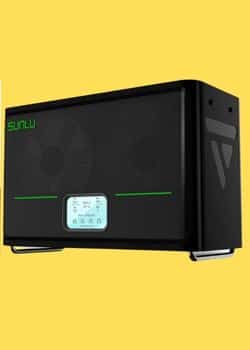 SUNLU FilaDryer S4 SUNLU FilaDryer S4 | Up to 4 kg | Adjustable | Continuous | Touch screen operation, drying while printing | Wide compatibility, effective moisture removal | Higher power consumption | Buy Now ($129.99) |
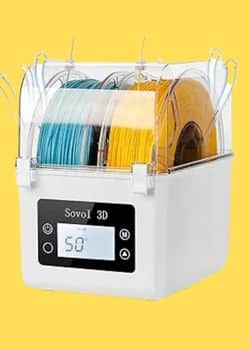 Sovol SH01 Filament Dryer Sovol SH01 Filament Dryer | Up to 2 kg | 40°C to 50°C | 6-12 hours | Excellent sealing, real-time monitoring | Affordable price, quiet operation | Manual settings, limited timer options | Buy Now ($52.99) |
 EIBOS Polyphemus Filament Dryer Box EIBOS Polyphemus Filament Dryer Box | Up to 3 kg | 20°C to 70°C | Customizable | Automatic rotation, humidity control | Large capacity, efficient heating | Complex setup for larger spools | Buy Now ($159.99) |
 THETA°NanoHex° Filament Dryer Box THETA°NanoHex° Filament Dryer Box | Varies | Adaptive | 10 min dehumidification | One-button operation, AI humidity control | Energy-efficient, quick dehumidification | Limited capacity info | Buy Now ($29.00) |
 Kingroon Filament Dryer Box Kingroon Filament Dryer Box | Varies | 50°C, 60°C, 70°C | 0-24 hours | Built-in fan, moisture expulsion | Effective moisture removal, safety features | Limited capacity info | Buy Now ($34.99) |
Additional Considerations
When selecting a filament dryer, consider factors such as noise levels during operation if you’re sensitive to sound or if you’ll be using it in a quiet environment. Additionally, check user reviews to gauge real-world performance and reliability before making your purchase.
Conclusion
Considering the balance between features, capacity, and price, the Polymaker PolyDryer stands out as the best option overall for serious 3D printing enthusiasts who require reliable performance and versatility in filament storage and drying. Its modular design and superior sealing make it an excellent investment for maintaining filament quality over time.
For budget-conscious users or those new to 3D printing, the Comgrow Filament Dryer offers a great entry point without compromising on essential drying capabilities at an affordable price of $39.99.
Frequently Asked Questions (FAQs)
How often should I dry my filaments?
It’s advisable to dry your filaments before each use if they have been stored for an extended period or if they are known to absorb moisture easily.
Can I use my oven as a filament dryer?
While some people use their ovens to dry filaments, it’s not recommended due to temperature inconsistencies and potential damage to the filament or oven itself
How long does it take to dry filament?
Drying times vary based on filament type and humidity levels but generally range from one hour to several hours depending on the conditions.
Is it safe to leave my filament dryer unattended?
Most quality filament dryers come with safety features such as automatic shut-off mechanisms; however, it’s always best practice to monitor them when in use.
Do I need a special type of dryer for different filament materials?
Yes, different materials have varying drying requirements; ensure that your dryer allows for temperature adjustments suitable for each type of filament you use.
By following these guidelines and choosing the right equipment, you’ll be well on your way to achieving high-quality prints with minimal hassle!



